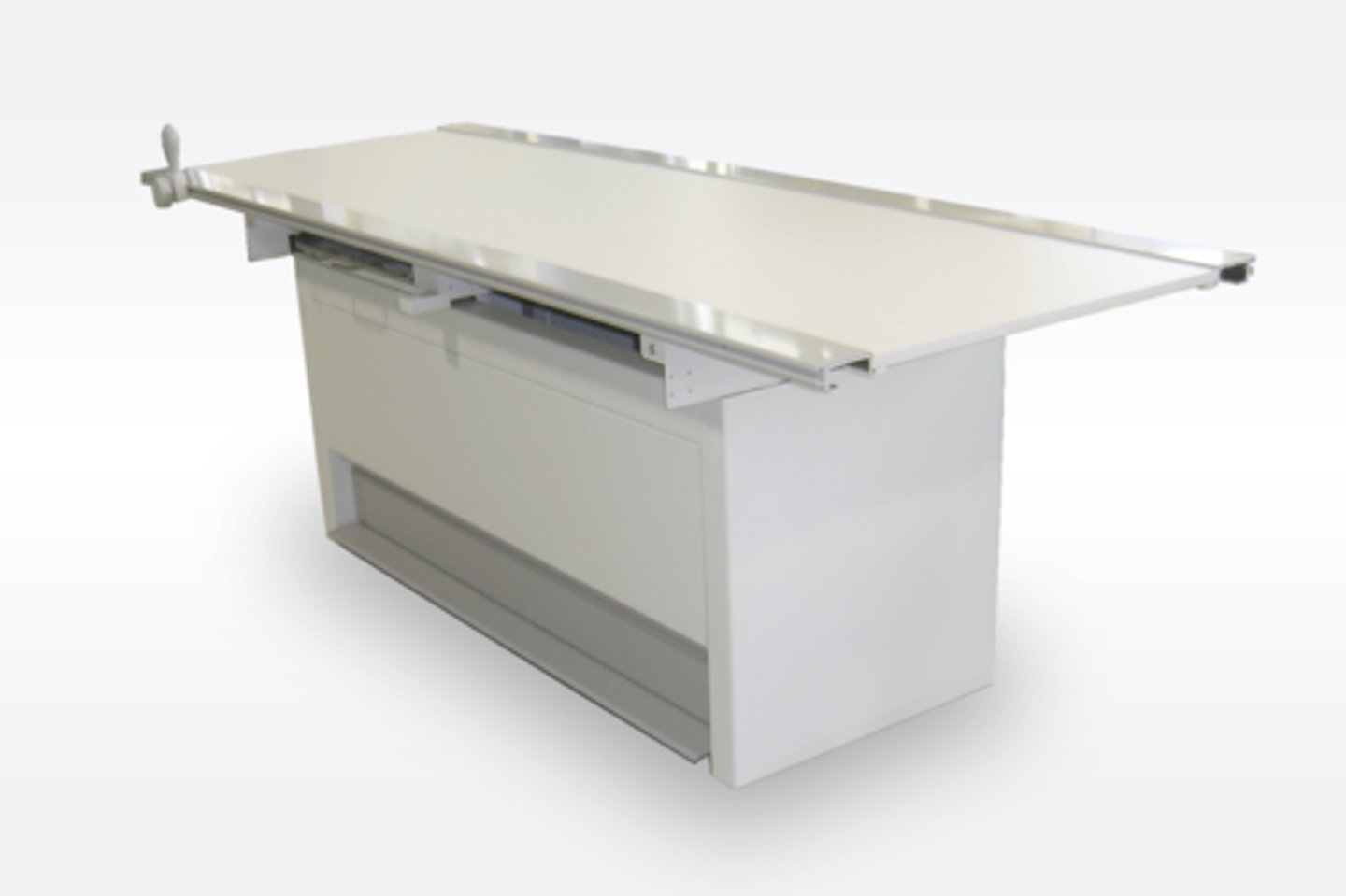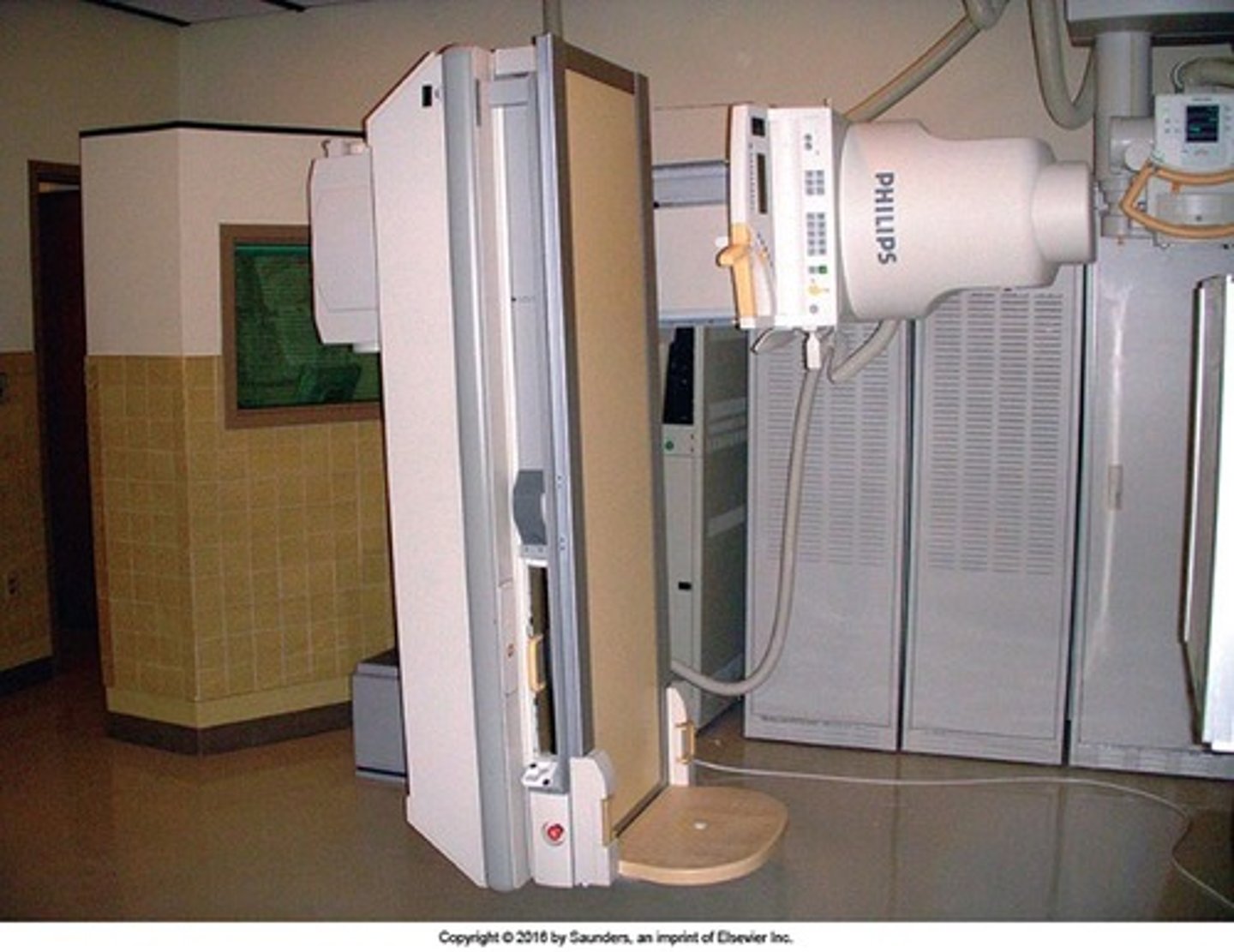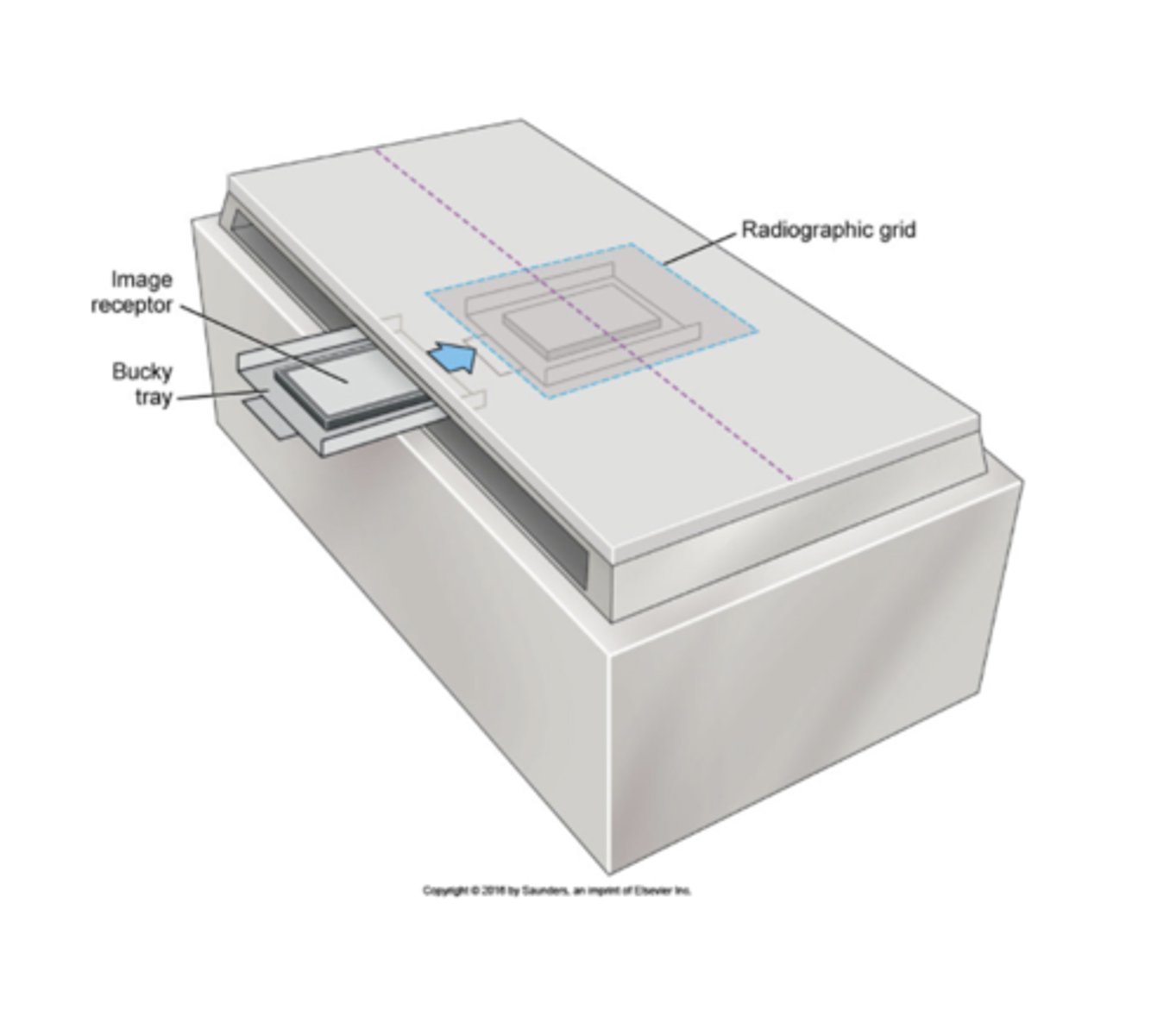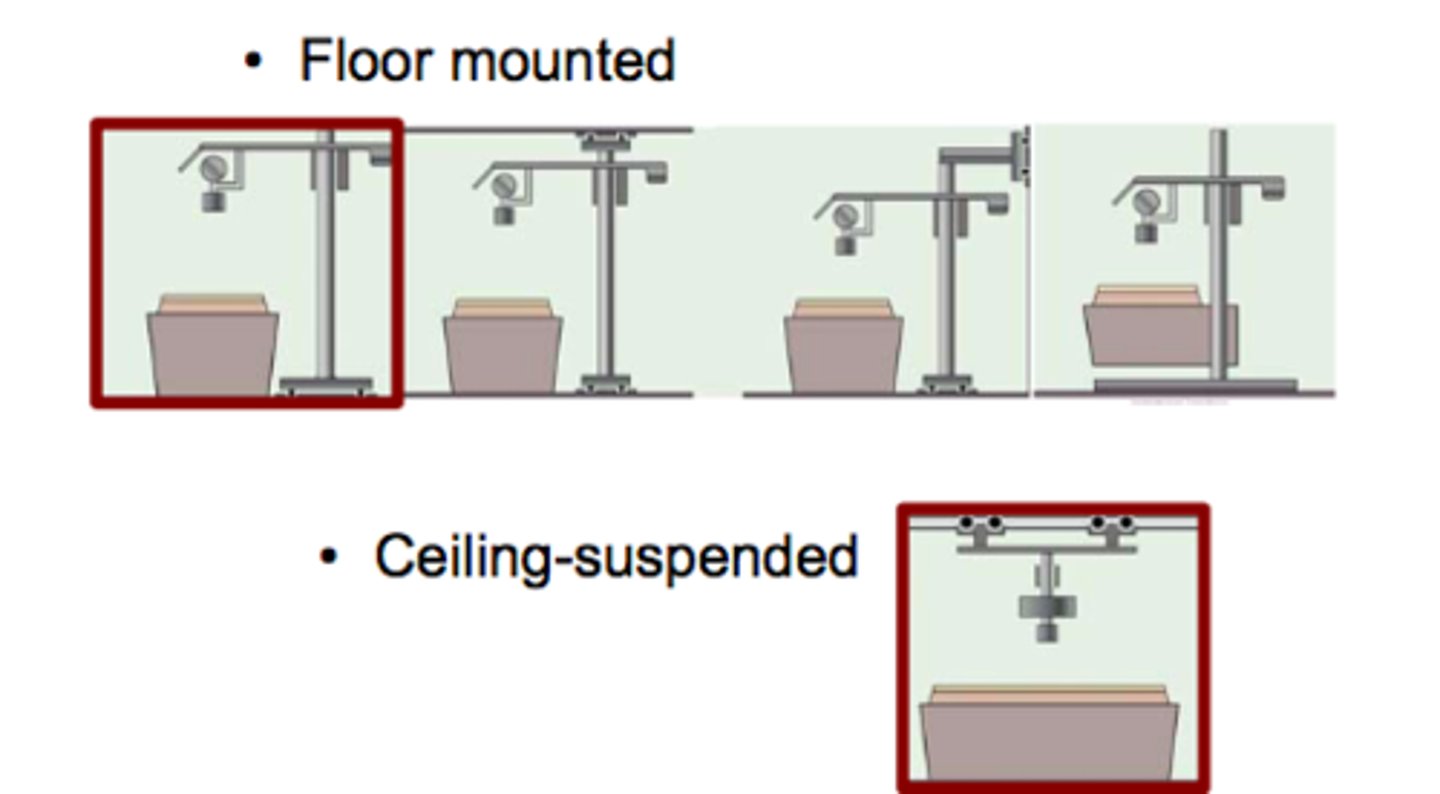Chapter 8 Medical Imaging equipment
1/28
There's no tags or description
Looks like no tags are added yet.
Name | Mastery | Learn | Test | Matching | Spaced |
|---|
No study sessions yet.
29 Terms
Diagnostic yield
The amount of clinically useful information on a diagnostic image
Diagnostic Efficacy
The accuracy of diagnostic information on a medical image is its diagnostic efficacy
X-Ray Machine Design Features
-X-ray tube and x-ray tube support
-Collimator assembly
-Radiographic table
-X-ray generator and control
-Upright image receptor
X-ray Tube Design
-Tube is inside a lead-lined metal housing
-Made of heat tolerant, Pyrex glass with high vacuum
-Produces X-radiation when high-energy electricity passes through the tube
-X-radiation exits the tube through a window in the housing and is directed toward a patient
Collimator assembly
-Controls the size and shape of the x-ray field directed toward the patient
-Projects a high-intensity light field on the patient, which represents the area of the x-ray field exposure
-May be manual or automatic (PBL) positive beam limitation
Radiographic Table
-May be fixed height or variable height
-Typically has a four-way "floating" tabletop
-Tabletop is highly radiolucent.
-Some table designs permit a variable-speed, tilting capability.

tilting radiographic table
These designs will tilt the table from horizontal position to vertical upright position to Trendelenburg.
-Most tables have four-way tabletop travel.
-These tables typically do not have variable height capabilities.
Tilting Radiographic table
A tilting radiographic/fluoroscopic table in the full upright position

Bucky Assembly
-Consists of a receptor tray and radiographic grid
-Tray holds receptor tightly in position and is centered to longitudinal axis of table.
-Radiographic grid oscillates during exposure to blur out the lead grid lines.
-Used with all image receptor systems
-Film-screen
-Computed Radiography
-Flat panel DR

Generator Control
Control console is the interface between the radiographer and the sophisticated electronics of the x-ray machine.
Console consists of:
-Main power switch
-Selection of exposure factors
-Exposure button
-Audio and visual display of actual x-ray exposure
-Visible display of all exposure factors
Generator Control
Most are microprocessor controlled and use a simple computer interface.
Permits selection of all exposure factors
-mAs
-kVp
-Focal spot size
-Automatic exposure control (AEC)
oAnatomical programming (APR)
Newer systems may be integrated into a digital radiographic (DR) detector.
Exposure Technique
-Consists of three key factors: mA, time, kVp
-Automatic exposure control (AEC) may be optional.
-Focal spot size selection
-Exposure technique selection may be anatomically programmed.
Exposure Technique Selection
-Generator consoles permit selection of kVp, mA, exposure time (S), and mAs.
-May be operated in mAs or timer mode
-Newer systems feature APR.
-Technique selection is critical to good radiography.
x-ray tube supports
Two basic designs
Facilitate easy and efficient positioning of the X-ray tube assembly around the patient in any orientation
Capable of various motions depending on need
Ergonomically friendly
Aesthetically pleasing and not intimidating to patients
Two types of x-ray tube support
Floor mounted tube stands and ceiling-suspended tuber cane system

Overhead Tubercane (OTC) Motions
Vertical travel
Longitudinal travel
Transverse travel
Vertical axis rotation
Tubehead rotation
Image Receptors
Cassette-based systems
oFilm-screen
oComputed radiography (CR)
Digital radiography (DR) systems
Referred to as flat-panel technology
oDR systems use thin-film transistors (TFTs)
Image receptor technology
receives remnant radiation from patient and captures the x-ray energy for processing
Classified as cassette-based and cassetteless
Historically, receptor was a cassette with intensifying screens and polyester film.
Newer systems are replacing the film-screen based technology with digital technology and image displayed on a video monitor
Important to remember
The only radiation that is of any clinical value is:
oRemnant radiation absorbed in the detector
oRemnant radiation is converted to an electrical signal, digitized, and sent to a computer for processing.
oFinally presented as a radiographic image for interpretation
Flat panel DR Technology
-replacing cassette based systems
-also known as flat panel detector (FPD)
-improved spatial resolution
-lower patient dose
DR technology
More dose efficient
Detectors are expensive and must be treated with care.
Sensitive to mechanical shock
Fluid invasion
Fluoroscopy
Provides live, real-time images of patients using X-rays
Standard of care for studying patient physiology and dynamics using x-radiation
Requires special equipment designs that feature an X-ray tube with attached image receptor in a perpendicular relationship
Used for a wide array of diagnostic procedures
Radiographic/Fluoroscopic (R/F) System
-Capable of static radiographic imaging (spot films) as well as live imaging (fluoroscopy)
-Capable of vertical tilting
-Spot film device with image intensifier is at right angle to x-ray tube during fluoroscopy.
-Table-side controls of tabletop motions
Interventional C-Arm Fluoroscopy System
-Used for interventional procedures
-Features a C-arm design with x-ray tube and image receptor
-Newer systems use a flat panel DR detector.
Mobile X-Ray Imaging
-Mobile radiographic units are used extensively in hospitals in many settings.
-Travel movement is motorized.
-Need to be plugged into wall outlet for charging when not in use
-X-ray capabilities similar to those of a fixed radiographic unit
-Designs are compact and user-friendly.
-Limited power for x-ray studies
Mobile X-Ray Features
-Motorized motion
-High-frequency output
-Exposure switch on a coiled cord to maximize distance from patient during exposure
-Newer systems use a wireless portable DR detector to replace cassette.
Cathode
-Creates free electrons through thermionic emission
-is the source of this negatively electrons
Anode
- where the x-rays are actually created
-Absorbs electrons and creates electrons from cathodes
Still learning (27)
You've started learning these terms. Keep it up!